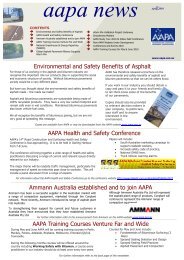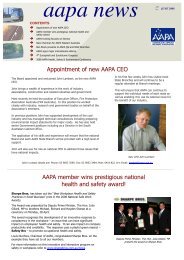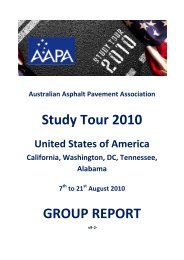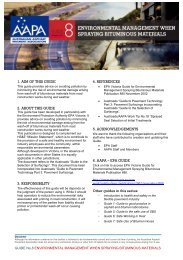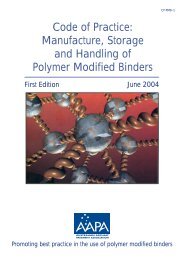RIICBS401A Apply the principles for the asphalt paving and ...
RIICBS401A Apply the principles for the asphalt paving and ...
RIICBS401A Apply the principles for the asphalt paving and ...
Create successful ePaper yourself
Turn your PDF publications into a flip-book with our unique Google optimized e-Paper software.
RII09 Resources <strong>and</strong> Infrastructure Industry Training Package (Version 1) Date this PDF was generated: 18 November 2009<strong>RIICBS401A</strong> <strong>Apply</strong> <strong>the</strong> <strong>principles</strong> <strong>for</strong> <strong>the</strong> <strong>asphalt</strong> <strong>paving</strong> <strong>and</strong> compaction<strong>RIICBS401A</strong>Unit DescriptorEmployability SkillsApplication of <strong>the</strong> Unit<strong>Apply</strong> <strong>the</strong> <strong>principles</strong> <strong>for</strong> <strong>the</strong> <strong>asphalt</strong> <strong>paving</strong><strong>and</strong> compactionThis unit covers <strong>the</strong> supervision of <strong>asphalt</strong> <strong>paving</strong> <strong>and</strong> compaction in<strong>the</strong> civil construction industry. It includes <strong>the</strong> requirements <strong>for</strong> ensuringthat <strong>the</strong> planning, preparing, initiating, monitoring, adjusting <strong>and</strong>reporting of <strong>asphalt</strong> <strong>paving</strong> <strong>and</strong> compaction tasks are carried out inaccordance with <strong>the</strong> accepted industry <strong>principles</strong>.This unit contains employability skills.This unit is appropriate <strong>for</strong> those working in a supervisory role oras a technical specialist, applying <strong>the</strong> <strong>principles</strong> <strong>for</strong> <strong>the</strong> <strong>asphalt</strong><strong>paving</strong> <strong>and</strong> compaction within:• Civil constructionUnit SectorBituminous SurfacingELEMENT1. Ensure appropriateplanning <strong>and</strong> preparationis carried out tasksPERFORMANCE CRITERIA1.1 Access, interpret <strong>and</strong> apply compliance documentationrelevant to <strong>the</strong> work activity1.2 Access, interpret <strong>and</strong> clarify <strong>the</strong> specific taskin<strong>for</strong>mation <strong>and</strong> requirements relevant to undertaking<strong>asphalt</strong> <strong>paving</strong> <strong>and</strong> compaction task1.3 Ensure a job plan is available which makes best use of<strong>the</strong> available resources <strong>and</strong> meets <strong>the</strong> task requirements2. Ensure appropriateinitiation of tasks is carriedout3. Oversee <strong>the</strong> execution oftasks4. Report on <strong>the</strong> execution oftasks2.1 Confirm that <strong>the</strong> necessary resources are available <strong>for</strong><strong>the</strong> safe, effective <strong>and</strong> efficient conduct of <strong>the</strong> tasks2.2 Ensure clear <strong>and</strong> timely instructions are communicatedto team members <strong>and</strong> o<strong>the</strong>rs involved, <strong>for</strong> <strong>the</strong> safe,effective <strong>and</strong> efficient conduct of <strong>the</strong> tasks, to meet <strong>the</strong>specific task requirements2.3 Set out tasks as required <strong>for</strong> <strong>the</strong> effective completion of<strong>the</strong> task3.1 Monitor task per<strong>for</strong>mance to ensure it achieves <strong>the</strong>required outcomes3.2 Initiate adjustments to work practice or job plan to ensuresafe execution of work <strong>and</strong> achievement of requiredoutcomes3.3 Ensure plant equipment <strong>and</strong> tools maintenancerequirements are carried out <strong>and</strong> recorded4.1 Complete <strong>and</strong> submit reports as required4.2 Recommend changes to improve <strong>the</strong> safety, efficiency<strong>and</strong> effectiveness of <strong>the</strong> execution of <strong>asphalt</strong> <strong>paving</strong> <strong>and</strong>compaction task tasksVolume 5 of 6, Unit 21 of 226 Page 182 of 1704© Commonwealth of Australia, To be reviewed by: 7 July 2012
RII09 Resources <strong>and</strong> Infrastructure Industry Training Package (Version 1) Date this PDF was generated: 18 November 2009<strong>RIICBS401A</strong> <strong>Apply</strong> <strong>the</strong> <strong>principles</strong> <strong>for</strong> <strong>the</strong> <strong>asphalt</strong> <strong>paving</strong> <strong>and</strong> compactionREQUIRED SKILLS AND KNOWLEDGEThis describes <strong>the</strong> essential skills <strong>and</strong> knowledge <strong>and</strong> <strong>the</strong>ir level, required <strong>for</strong> this unit.Required skillsSpecific skills are required to achieve <strong>the</strong> per<strong>for</strong>mance criteria in this unit, particularly <strong>for</strong> <strong>the</strong>application in <strong>the</strong> various circumstances in which this unit may be applied. This includes <strong>the</strong>ability to carry out <strong>the</strong> following as required to apply <strong>the</strong> <strong>principles</strong> <strong>for</strong> <strong>the</strong> <strong>asphalt</strong> <strong>paving</strong> <strong>and</strong>compaction:• apply legislative, organisation <strong>and</strong> site requirements <strong>and</strong> procedures• interpret project contract <strong>and</strong> specification requirements <strong>and</strong> procedures• interpret project site soil <strong>and</strong> geological data• identify soil <strong>and</strong> rock types• interpret meteorological data• identify drainage issues• interpret material properties <strong>and</strong> test results, including compaction test results• interpret project site geotechnical data• interpret project site hydrological data• interpret project engineering survey in<strong>for</strong>mation• interpret project plans <strong>and</strong> drawings• interpret project specifications• prepare <strong>for</strong> <strong>and</strong> conduct briefings, toolbox <strong>and</strong> site meeting• prepare short messages• prepare <strong>and</strong> present job reports• prepare <strong>and</strong> maintain log books <strong>and</strong> diaries• provide leadership• apply per<strong>for</strong>mance monitoring skills• apply set out requirements <strong>and</strong> procedures• set up <strong>and</strong> use levelling devices• establish construction offsets• apply supervisory skills• develop workplace relationships• develop individuals <strong>and</strong> <strong>the</strong> team• apply inspection requirements <strong>and</strong> procedures• calculate quantities <strong>for</strong> <strong>the</strong> execution of tasks, including:• volumes• tonnage required• paver <strong>and</strong> roller speeds• grades• percentages• areas• resource consumption figures, including required supply rates• provide recommendations <strong>for</strong> <strong>the</strong> improvement of <strong>the</strong> safe, effective <strong>and</strong> efficientexecution of <strong>asphalt</strong> <strong>paving</strong> <strong>and</strong> compaction tasksRequired knowledgeSpecific knowledge is required to achieve <strong>the</strong> Per<strong>for</strong>mance Criteria of this unit, particularly itsapplication in a variety of circumstances in which <strong>the</strong> unit may be used. This includesknowledge of <strong>the</strong> following, as required to apply <strong>the</strong> <strong>principles</strong> <strong>for</strong> <strong>the</strong> <strong>asphalt</strong> <strong>paving</strong> <strong>and</strong>compaction:• risk assessment <strong>and</strong> management requirement <strong>and</strong> procedures• statutory compliance requirements <strong>and</strong> procedures• occupational health <strong>and</strong> safety requirements <strong>and</strong> proceduresVolume 5 of 6, Unit 21 of 226 Page 183 of 1704© Commonwealth of Australia, To be reviewed by: 7 July 2012
RII09 Resources <strong>and</strong> Infrastructure Industry Training Package (Version 1) Date this PDF was generated: 18 November 2009<strong>RIICBS401A</strong> <strong>Apply</strong> <strong>the</strong> <strong>principles</strong> <strong>for</strong> <strong>the</strong> <strong>asphalt</strong> <strong>paving</strong> <strong>and</strong> compaction• environmental management requirements <strong>and</strong> procedures• quality management requirements <strong>and</strong> procedures• work zone traffic management requirements <strong>and</strong> procedures• contract management requirements <strong>and</strong> procedures• communication requirements <strong>and</strong> procedures• administrative requirements <strong>and</strong> procedures• plant <strong>and</strong> equipment capabilities <strong>and</strong> application• plant, equipment <strong>and</strong> tools maintenance requirements <strong>and</strong> procedures• operational techniques• resource requirements <strong>and</strong> procedures• activities scheduling requirements <strong>and</strong> procedures• job plan drafting of <strong>and</strong> administration requirements <strong>and</strong> procedures• reporting requirements <strong>and</strong> procedures• workplace relationship requirements <strong>and</strong> procedures• organisational, client <strong>and</strong> site operational requirements• relationship between various areas of civil works• team leadership techniques• materials quality <strong>and</strong> delivery requirements <strong>and</strong> procedures• mentoring techniques• estimating <strong>principles</strong>• road construction sequencing• <strong>asphalt</strong> placement <strong>and</strong> compaction <strong>and</strong> related activities terminology• set out requirements <strong>and</strong> procedures• road geometry• pavement drainage requirements• works planning techniques• monitoring methods• engineering survey <strong>principles</strong>• characteristics, application <strong>and</strong> requirements <strong>and</strong> procedures <strong>for</strong> different types of<strong>asphalt</strong>• <strong>asphalt</strong> mix design philosophy <strong>and</strong> test methods relating to <strong>paving</strong> <strong>and</strong> compaction• straight line <strong>and</strong> intersection <strong>paving</strong> <strong>and</strong> compaction requirements <strong>and</strong> proceduresRANGE STATEMENTThe range statement relates to <strong>the</strong> unit of competency as a whole. It allows <strong>for</strong> different workenvironments <strong>and</strong> situations that may affect per<strong>for</strong>mance. Bold italicised wording, if used in <strong>the</strong>per<strong>for</strong>mance criteria, is detailed below. Essential operating conditions that may be present withtraining <strong>and</strong> assessment (depending on <strong>the</strong> work situation, needs of <strong>the</strong> c<strong>and</strong>idate, accessibility of <strong>the</strong>item, <strong>and</strong> local industry <strong>and</strong> regional contexts) may also be included.Relevant compliancedocumentation mayinclude:• legislative, organisational <strong>and</strong> site requirements <strong>and</strong>procedures• manufacturer's guidelines <strong>and</strong> specifications• Australian st<strong>and</strong>ards• code of practice• Employment <strong>and</strong> workplace relations legislation• Equal Employment Opportunity <strong>and</strong> DisabilityDiscrimination legislationVolume 5 of 6, Unit 21 of 226 Page 184 of 1704© Commonwealth of Australia, To be reviewed by: 7 July 2012
RII09 Resources <strong>and</strong> Infrastructure Industry Training Package (Version 1) Date this PDF was generated: 18 November 2009<strong>RIICBS401A</strong> <strong>Apply</strong> <strong>the</strong> <strong>principles</strong> <strong>for</strong> <strong>the</strong> <strong>asphalt</strong> <strong>paving</strong> <strong>and</strong> compactionSpecific task in<strong>for</strong>mation<strong>and</strong> requirements mayinclude:• site geological <strong>and</strong> geotechnical data, including:• rock types <strong>and</strong> characteristics• soil types <strong>and</strong> characteristics• site hydrological data, including:• surface water• ground water• site meteorological data, including:• rainfall• humidity• temperature• wind• site engineering survey data• known <strong>and</strong> potential site hazards, constraints <strong>and</strong>conditions• site cultural <strong>and</strong> heritage in<strong>for</strong>mation• task specifications• task drawings• sources of materials• types of <strong>asphalt</strong>• o<strong>the</strong>r organisations <strong>and</strong> contractors involved in <strong>the</strong> task orrelated tasks• coordination, timing <strong>and</strong> budgeting requirementsAsphalt <strong>paving</strong> <strong>and</strong>compactionmay include:• new pavement construction• existing pavement repair <strong>and</strong> maintenanceJob plan is to include: • human resource requirements• plant <strong>and</strong> machinery requirements• construction materials requirements• sub-contractor support requirements• waste disposal requirements• coordination requirements• activity scheduling• materials delivery scheduling• risk assessment <strong>and</strong> management requirements• occupational health <strong>and</strong> safety requirements• quality management requirements, including testingscheduling requirements• traffic management requirements• environmental requirements• task monitoring requirements• task per<strong>for</strong>mance monitoring requirements• communication requirements• reporting requirementsVolume 5 of 6, Unit 21 of 226 Page 185 of 1704© Commonwealth of Australia, To be reviewed by: 7 July 2012
RII09 Resources <strong>and</strong> Infrastructure Industry Training Package (Version 1) Date this PDF was generated: 18 November 2009<strong>RIICBS401A</strong> <strong>Apply</strong> <strong>the</strong> <strong>principles</strong> <strong>for</strong> <strong>the</strong> <strong>asphalt</strong> <strong>paving</strong> <strong>and</strong> compactionResources are to include: • labour• plant, equipment <strong>and</strong> tools• material supply vehicles• construction materials, such as emulsion <strong>and</strong> <strong>asphalt</strong>• sub-contractor servicesInstructions are toinclude:• briefings• h<strong>and</strong>overs• work orders• toolbox meetings• site meetingsTeam members mayinclude:• o<strong>the</strong>r members of <strong>the</strong> organisation's management team• members of <strong>the</strong> team directly involved in <strong>the</strong> task• suppliers representatives• sub-contractors representatives• supervisors or managers of o<strong>the</strong>r organisations who areinvolved in related tasksSet out is to include: • control lines• cleared width• batters• off-setsMonitor is to include: • ongoing risk assessment• engineering survey• sampling <strong>and</strong> testing• observation <strong>and</strong> recording• general supervisionRequired outcomesmay include:• task specifications requirements• task drawings requirements• coordination requirements• activity scheduling requirements• unit cost requirements• overall task cost requirements• waste management requirementsInitiate is to include: • written communication• oral communicationVolume 5 of 6, Unit 21 of 226 Page 186 of 1704© Commonwealth of Australia, To be reviewed by: 7 July 2012
RII09 Resources <strong>and</strong> Infrastructure Industry Training Package (Version 1) Date this PDF was generated: 18 November 2009<strong>RIICBS401A</strong> <strong>Apply</strong> <strong>the</strong> <strong>principles</strong> <strong>for</strong> <strong>the</strong> <strong>asphalt</strong> <strong>paving</strong> <strong>and</strong> compactionEVIDENCE GUIDEThe evidence guide provides advice on assessment <strong>and</strong> must be read in conjunction with <strong>the</strong>per<strong>for</strong>mance criteria, required skills <strong>and</strong> knowledge, range statement <strong>and</strong> <strong>the</strong> Assessment Guidelines<strong>for</strong> <strong>the</strong> Training Package.Overview of assessmentCritical aspects <strong>for</strong>assessment <strong>and</strong> evidencerequired to demonstratecompetency in this unitThe evidence required to demonstrate competency in this unitmust be relevant to worksite operations <strong>and</strong> satisfy all of <strong>the</strong>requirements of <strong>the</strong> per<strong>for</strong>mance criteria, required skills <strong>and</strong>knowledge <strong>and</strong> <strong>the</strong> range statement of this unit <strong>and</strong> includeevidence of <strong>the</strong> following:• knowledge of <strong>the</strong> requirements, procedures <strong>and</strong>instructions <strong>for</strong> <strong>the</strong> application of <strong>the</strong> <strong>principles</strong> <strong>for</strong> <strong>the</strong><strong>asphalt</strong> <strong>paving</strong> <strong>and</strong> compaction• implementation of procedures <strong>and</strong> techniques <strong>for</strong> <strong>the</strong>safe, effective <strong>and</strong> efficient application of <strong>the</strong> <strong>principles</strong> <strong>for</strong><strong>the</strong> <strong>asphalt</strong> <strong>paving</strong> <strong>and</strong> compaction• working with o<strong>the</strong>rs to plan, prepare <strong>and</strong> conduct <strong>asphalt</strong><strong>paving</strong> <strong>and</strong> compaction• provision of clear <strong>and</strong> timely instruction <strong>and</strong> supervisionby <strong>the</strong> individual of those involved in <strong>the</strong> <strong>asphalt</strong> <strong>paving</strong><strong>and</strong> compaction• evidence of <strong>the</strong> consistent successful application of <strong>the</strong><strong>principles</strong> <strong>for</strong> <strong>the</strong> <strong>asphalt</strong> <strong>paving</strong> <strong>and</strong> compactionVolume 5 of 6, Unit 21 of 226 Page 187 of 1704© Commonwealth of Australia, To be reviewed by: 7 July 2012
RII09 Resources <strong>and</strong> Infrastructure Industry Training Package (Version 1) Date this PDF was generated: 18 November 2009<strong>RIICBS401A</strong> <strong>Apply</strong> <strong>the</strong> <strong>principles</strong> <strong>for</strong> <strong>the</strong> <strong>asphalt</strong> <strong>paving</strong> <strong>and</strong> compactionContext of <strong>and</strong> specificresources <strong>for</strong> assessment• This unit must be assessed in <strong>the</strong> context of <strong>the</strong> workenvironment. Where personal safety or environmentaldamage are limiting factors, assessment may occur in asimulated environment provided it is realistic <strong>and</strong>sufficiently rigorous to cover all aspects of workplaceper<strong>for</strong>mance, including task skills, task managementskills, contingency management skills <strong>and</strong> job roleenvironment skills.• Evidence <strong>for</strong> assessment is best ga<strong>the</strong>red using <strong>the</strong>outcomes of products <strong>and</strong> processes in <strong>the</strong> workplace.• The assessment environment should not disadvantage<strong>the</strong> participant. For example, language, literacy <strong>and</strong>numeracy dem<strong>and</strong>s of assessment should not be greaterthan those required on <strong>the</strong> job.• Customisation of assessment <strong>and</strong> delivery environment tosensitively accommodate cultural diversity.• Aboriginal people <strong>and</strong> o<strong>the</strong>r people from a non Englishspeaking background may have second language issues.• Assessment of this competency requires typicalresources normally used in a resources <strong>and</strong> infrastructuresector environment. Selection <strong>and</strong> use of resources <strong>for</strong>particular worksites may differ due to <strong>the</strong> sitecircumstances.• Where applicable, physical resources should includeequipment modified <strong>for</strong> people with disabilities.• Access must be provided to appropriate learning <strong>and</strong>/orassessment support when required.Method of assessmentThis unit may be assessed in a holistic way with o<strong>the</strong>r units ofcompetency. The assessment strategy <strong>for</strong> this unit must verifyrequired knowledge <strong>and</strong> skill <strong>and</strong> practical application usingmore than one of <strong>the</strong> following assessment methods:• written <strong>and</strong>/or oral assessment of <strong>the</strong> c<strong>and</strong>idate's requiredknowledge• observed, documented <strong>and</strong>/or first h<strong>and</strong> testimonialevidence of <strong>the</strong> c<strong>and</strong>idate's:• implementation of appropriate procedures <strong>and</strong>techniques <strong>for</strong> <strong>the</strong> safe, effective <strong>and</strong> efficientachievement of <strong>the</strong> required outcomes• consistently achieving <strong>the</strong> required outcomes• first h<strong>and</strong> testimonial evidence of <strong>the</strong> c<strong>and</strong>idate's:• working with o<strong>the</strong>rs to plan, prepare <strong>and</strong> conduct<strong>asphalt</strong> <strong>paving</strong> <strong>and</strong> compaction• provision of clear <strong>and</strong> timely instruction <strong>and</strong>supervision by <strong>the</strong> individual of those involved in <strong>the</strong>conduct of <strong>asphalt</strong> <strong>paving</strong> <strong>and</strong> compactionGuidance in<strong>for</strong>mation <strong>for</strong>assessmentConsult <strong>the</strong> SkillsDMC User Guide <strong>for</strong> fur<strong>the</strong>r in<strong>for</strong>mation onassessment including access <strong>and</strong> equity issues.Volume 5 of 6, Unit 21 of 226 Page 188 of 1704© Commonwealth of Australia, To be reviewed by: 7 July 2012



